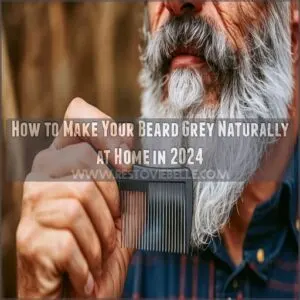This site is supported by our readers. We may earn a commission, at no cost to you, if you purchase through links.

To style a thin beard, first examine your facial hair pattern and consider genetic, hormonal, and lifestyle factors that may contribute to thin patches. Make sure you’re getting adequate omega-3 fatty acids and vitamin A from your diet. Regular exercise and sufficient sleep can also help support beard growth.
Before shaving, exfoliate to remove dead skin cells and unclip follicles. Use a small amount of styling product and a fine-toothed comb to shape and train your facial hair.
Some flattering styles for thin beards include the complete goatee, Van Dyke, anchor, and balbo. Keep reading for more in-depth tips on embracing your unique facial hair.
Table Of Contents
Key Takeaways
- Examine facial hair pattern and consider genetic, hormonal, and lifestyle factors that may contribute to thin patches.
- Regular exercise and sufficient sleep can support beard growth.
- Choose a flattering beard style that complements your facial features and hair growth pattern.
- Implement proactive measures to acknowledge your distinct facial hair and explore novel styling methods.
How to Style a Thin Beard?
To style a thin beard, follow these tips:
- Let your facial hair grow for several weeks before trimming and shaping it to emphasize its best qualities.
- Use a quality beard wash, beard moisturizer, and beard oil to nourish your skin and follicles, reducing dryness and itchiness.
- Trim and taper thinner areas, such as around the cheeks, jaw, or chin, to create clean, defined angles and lines that allow thicker areas to bulk up.
- Consider a style like the balbo, which is ideal for thin beards and can be worn with or without a mustache.
- Embrace the natural growth pattern of your beard and avoid styles that may not suit your facial hair.
- Be patient and give your beard time to grow, as patches may fill in or appear fuller after four weeks of growth.
- Maintain a balanced diet rich in proteins and vitamins, as well as a regular grooming routine, to encourage healthy beard growth.
By following these tips, you can enhance the appearance of your thin beard and achieve a more confident look.
Identify Bald Spots
To identify bald spots in your beard, start by examining your facial hair growth pattern. Look for areas where hair growth is sparse or non-existent. These bald spots can be caused by genetics, hormonal imbalances, or lifestyle factors. To manage bald spots effectively, consider the following tips:
- Genetics: Understand your family history and genetic predisposition to thin beards.
- Age: Beards tend to thicken in early adulthood, so patience may be required.
- Nutrition: Make sure you have a balanced diet rich in essential nutrients for beard growth.
- Exfoliation: Regularly exfoliate your skin before shaving to remove dead skin cells and improve hair growth.
- Trimming: Keep your beard trimmed to maintain a uniform appearance and hide patches.
- Styling: Choose a beard style that complements your facial features and hair growth pattern.
Examine Root Causes (hormones, Diet, Lifestyle)
Nutritional deficiencies like low omega-3 fatty acids and vitamin A can impact beard growth. Making lifestyle changes like regular exercise and getting sufficient sleep may also help thicken your thin beard.
omega-3 fatty acids
Omega-3 fatty acids play a significant role in maintaining healthy skin and hair follicles, which can help promote beard growth. These vital nutrients are found in fatty fish, such as mackerel, salmon, herring, and sardines, as well as in plant-based sources like flaxseeds, chia seeds, and walnuts.
Aim for a minimum of 250-500 mg combined EPA and DHA per day for healthy adults, and consider supplements if necessary. However, be cautious of potential risks, such as blood thinning or excessive bleeding, especially if you’re planning surgery.
Always consult with a healthcare professional before starting any new supplement regimen.
vitamin A
Omega-3 fatty acids lay the groundwork for a flourishing beard. Vitamin A steps into the spotlight, ensuring your facial hair doesn’t hit a growth snag. A deficiency in this nutrient could leave your beard looking more desert than lush oasis.
Incorporate vitamin A-rich foods or supplements into your routine, and watch your grooming efforts bear fruit—or, in this case, beard.
Consider lifestyle changes: Regular exercise
Exercise: The Key to a Fuller Beard
Exercise is essential for overall well-being and can significantly contribute to beard development. Here are three ways exercise can help you grow a denser beard:
- Enhanced Blood Flow: Exercise increases blood circulation throughout your body, including your face. This increased circulation supplies essential nutrients and oxygen to hair follicles, potentially creating a conducive environment for beard growth.
- Testosterone Upregulation: Regular exercise can promote testosterone levels, a hormone that supports ideal metabolic processes and contributes to beard growth.
- Healthy Hair Follicles: Exercise stimulates the production of growth hormones, which can enhance the health of your hair, including your beard.
To optimize the benefits of exercise for your beard, consider incorporating resistance training, high-intensity interval training (HIIT), and facial exercises into your workout regimen. These types of exercises can help stimulate beard growth by fostering hormonal balance and increasing hair follicle activity.
sufficient sleep
Essential sleep is paramount for upholding hormonal equilibrium, which can influence beard development. Target 7-9 hours of sleep each night.
Enhance sleep quality by adhering to optimal sleep habits, including abstaining from screen usage before sleep, maintaining a chilly room temperature, and establishing a calming bedtime routine.
If you encounter difficulties with sleep apnea, consider utilizing a CPAP apparatus or seeking professional medical counsel.
A well-rested body is more inclined to facilitate a flourishing beard.
Exfoliate Before Shaving to Remove Dead Skin Cells
Exfoliating your beard before shaving is essential for maintaining healthy beard growth and preventing issues like ingrown hairs and razor burn. This process removes dead skin cells, unclogs hair follicles, and prepares the skin for a smoother shave. Here’s a step-by-step guide on how to exfoliate your beard effectively:
- Wet Your Beard: Start by wetting your beard thoroughly, as this softens the hair and makes exfoliation more comfortable.
- Apply the Exfoliant: Take a small amount of your chosen exfoliating product, such as a beard scrub, and gently rub it into your beard using circular motions. Start from the neck and work your way up to your chin. Be careful not to press too hard, as this can irritate the skin.
- Rinse Thoroughly: After exfoliating for about one to two minutes, rinse your beard thoroughly with warm water to remove all the exfoliating product.
- Pat Dry Gently: Gently pat your beard dry with a clean towel, avoiding vigorous rubbing that can damage the hair and irritate the skin.
- Moisturize: Apply a quality beard oil or moisturizer to keep the skin and hair hydrated and healthy.
Exfoliating before shaving has several benefits:
- Removes Dead Skin Cells: Exfoliation helps get rid of dead skin cells that can accumulate on the skin’s surface, preventing hair from growing freely.
- Promotes Healthy Growth: Unclogging hair follicles allows for better air circulation and healthier hair growth.
- Reduces Ingrown Hairs: Exfoliation can help prevent and alleviate ingrown hairs, a common issue among beard wearers.
- Enhances Product Absorption: Exfoliated skin absorbs beard oils, balms, and moisturizers more effectively.
Remember to exfoliate your beard once or twice a week, depending on your skin type and needs. Over-exfoliating can lead to irritation and dryness, so pay attention to your skin’s response.
Style With Products and Comb
To style your thin beard and enhance its appearance, consider using the following products and techniques:
- Beard oil: Moisturize your beard and the skin beneath it, preventing itchiness and promoting healthy growth. Choose a high-quality beard oil that suits your hair type and provides a pleasant scent.
- Beard balm: Condition, moisturize, and soften your beard, while offering a light hold for styling. This makes it easier to maintain your desired beard shape throughout the day.
- Beard comb or brush: Organize your facial hair, ensuring each strand is in the right place and at the right angle. This will make it easier to trim or sculpt your beard to your desired style.
Best Styles: Complete Goatee, Van Dyke, Anchor, Balbo, Stubble
| After immersing yourself in the realm of products and combs, let’s shift gears to the primary focus: selecting your preferred style. Whether you aspire to be a master beard aficionado or simply desire to command your facial growth with assurance, these styles are your weaponry. | Style | Description | Why It Works |
|---|---|---|---|
| Goatee | A traditional style covering cheek and jawline patches | Goatee styles offer a dignified yet approachable demeanor. | |
| Van Dyke | A striking full mustache with a goatee | Van Dyke variations radiate sophistication and precision. | |
| Anchor | A refined Van Dyke minus the jawline beard | The Anchor shape commands attention, breaking free from the conventional. | |
| Balbo | A disconnected mustache with a more robust goatee | Balbo’s connectedness imparts a distinct, distinguished flair. | |
| Stubble | Brief, timeless, and effortlessly cool | Stubble length is the covert weapon for a subtle yet powerful impact. |
Choose judiciously, and let your beard not merely flourish, but reign supreme.
Frequently Asked Questions (FAQs)
How can I identify bald spots in my beard?
Uncover your facial canvas like a detective – scour your beard for patchy plots, then trim away the dead ends to reveal your full potential. Expose those elusive bald spots and take control of your look.
What are the best products to use for beard care?
Supercharge your thin beard with a dynamic trio – soothing shave soap, nourishing pre-shave oil, and revitalizing aftershave. These essential products will condition, soften, and promote healthier growth for your facial masterpiece.
How often should I trim my beard?
Did you know men trim their beards every 2-4 weeks on average? That said, your beard type and growth rate dictate the best trim schedule. Listen to your face, not a calendar – trim when it looks messy, not on a schedule.
What are some common mistakes to avoid when styling a thin beard?
Don’t shave daily, neglect grooming, or keep patchy growth – that’ll just slow progress. Instead, exfoliate, use the right products, and trim wisely to maximize your thin beard’s potential.
Can a thin beard grow thicker with time?
With patience and perseverance, your thin beard can truly blossom into its full potential. Have faith – the power to grow a lush, manly mane lies within you, just waiting to be freed.
Conclusion
Concerning styling a thin beard, the crucial aspect is to initiate proactive measures. By discerning the underlying causes and implementing lifestyle modifications, you can acknowledge your distinct facial hair and embark on the exploration of novel approaches.
Exploring diverse styling methods, you can fashion a flattering thin beard style, such as the traditional Van Dyke or the striking balbo. With a touch of innovation and perseverance, you can control that thin beard and embody the look of your liking.











